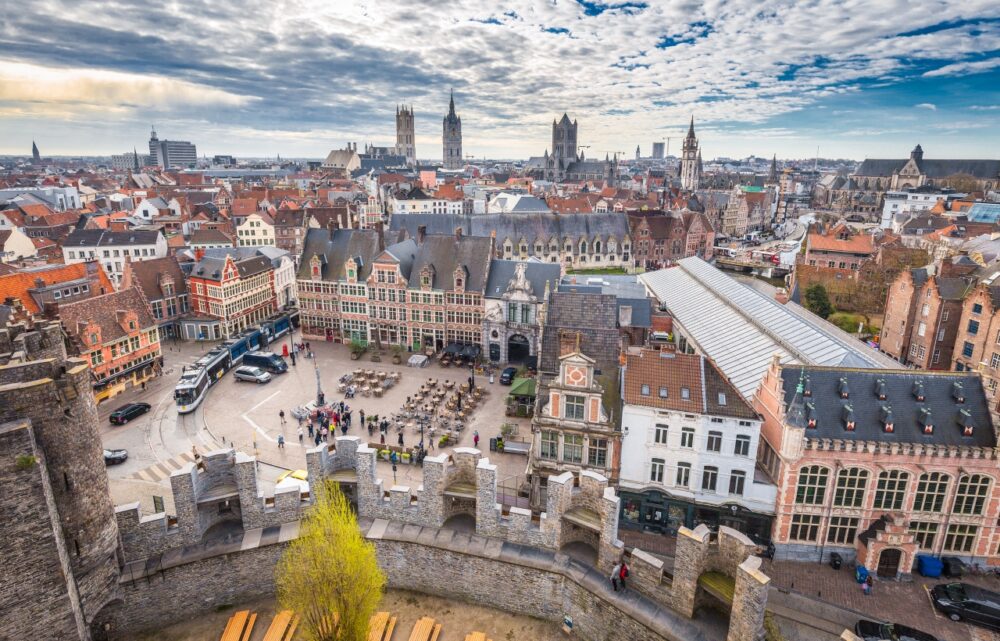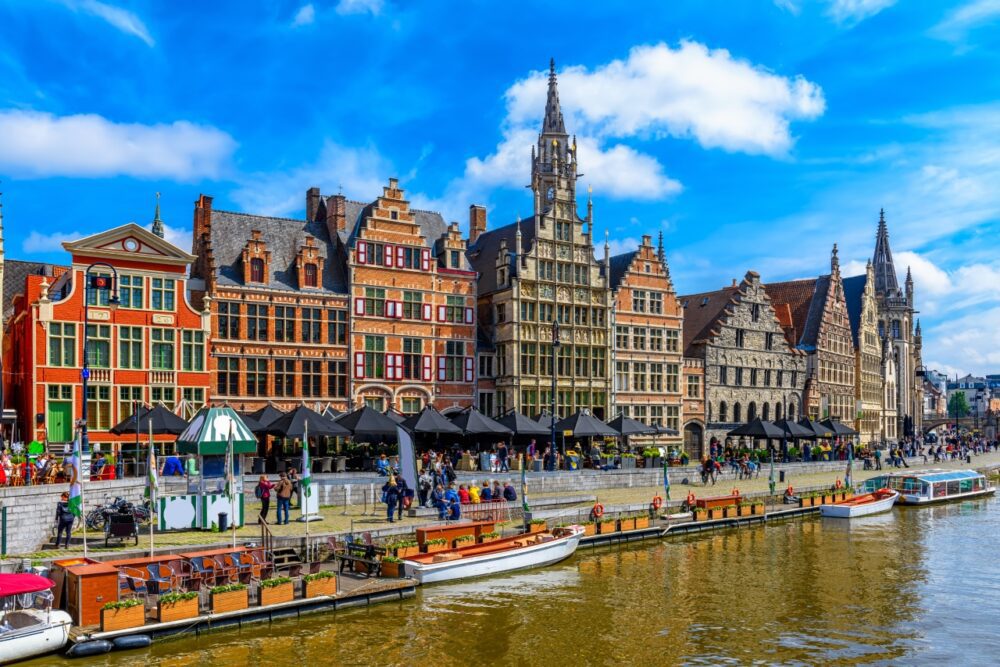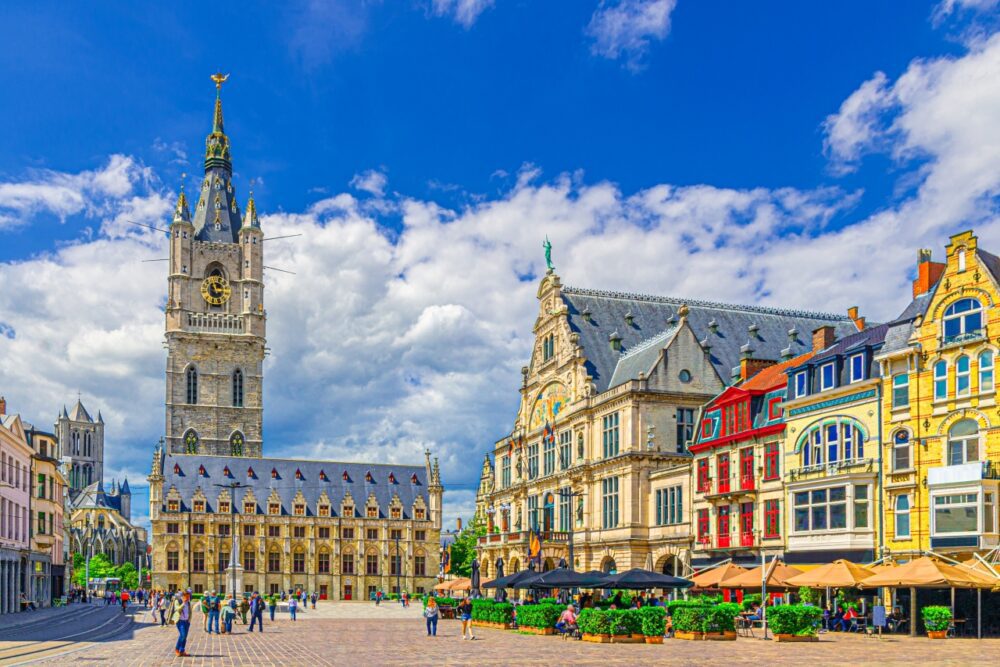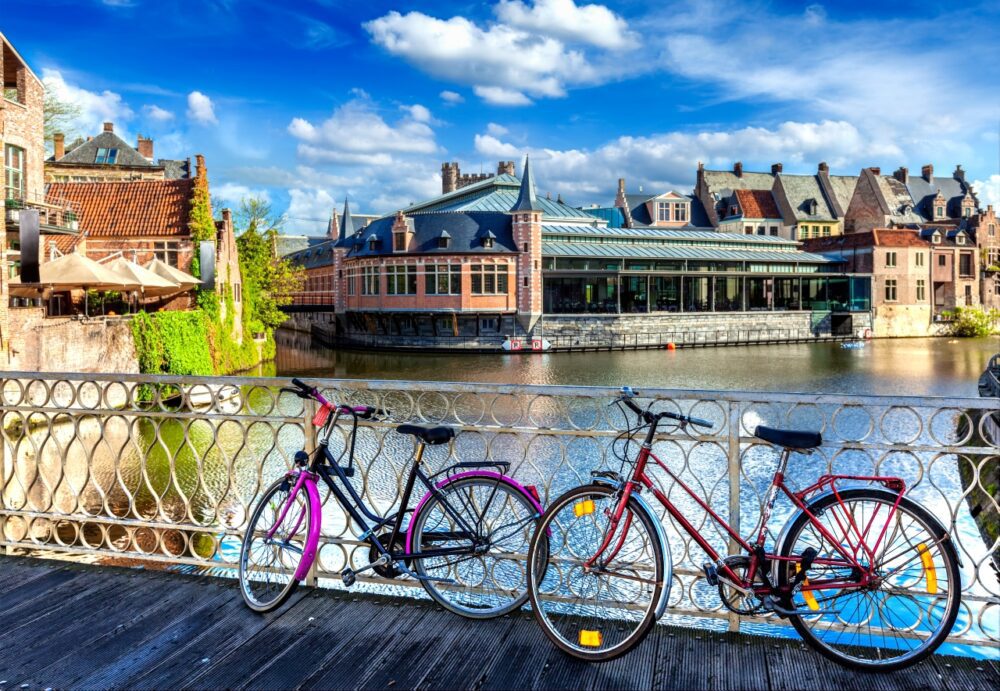
Is Ghent worth visiting? In my opinion, it absolutely is. The first time I set foot in Ghent, I was amazed at how this Belgian city manages to feel both grand and cosy at the same time. From the medieval towers rising over the skyline to the vibrant canals lined with quirky bars and restaurants, Ghent is a place that draws you in with its charm and leaves you wanting more.
Located in the heart of Belgium, Ghent is often overshadowed by its more famous neighbours, Bruges and Brussels. But those who take the time to explore will discover a city full of surprises. Known for its stunning Gothic architecture, lively student vibe, and artistic heritage, Ghent is a cultural gem with a welcoming atmosphere. Whether you’re marvelling at the Adoration of the Mystic Lamb in St. Bavo’s Cathedral or enjoying a canal cruise under the twinkling lights of the Graslei, Ghent offers an unforgettable experience. But is Ghent worth visiting for you?
In this blog post, we’ll uncover the top 10 reasons why Ghent should be on your travel list. From its historic landmarks to its thriving food and beer scene, we’ll explore what makes this city so unique. Plus, we’ll share practical travel tips to help you make the most of your visit. Keep reading, and you’ll see why Ghent deserves a spot on your Belgium itinerary.
Table of Contents
Pros – Reasons You Should Visit Ghent
1. Stunning Medieval Architecture

Ghent is an architectural wonderland, especially for anyone who loves medieval buildings. The Gravensteen Castle, a 12th-century fortress complete with turrets and a moat, is a jaw-dropping sight right in the heart of the city. And then there’s the Saint Bavo’s Cathedral, a Gothic masterpiece that houses the world-famous Ghent Altarpiece by the Van Eyck brothers. Simply put, Ghent is a dream come true for history and architecture enthusiasts.
I remember walking through the historic centre and being blown away by the beauty around every corner. The Korenmarkt and Graslei streets, with their stunning facades, feel like stepping back in time. To fully appreciate the architecture, I recommend taking a guided walking tour. You’ll get plenty of context for the buildings, plus some fun anecdotes from the city’s colourful past.
2. Picturesque Canals

Ghent’s canals are just as lovely as those in Bruges but without the massive crowds. The city is perfect for a leisurely boat tour, where you can admire the waterside architecture and learn about the history of the area. The Graslei and Korenlei embankments are particularly stunning, lined with centuries-old buildings that are beautifully reflected in the water.
I took a sunset boat tour, and it was a highlight of my trip. The soft golden light hitting the medieval buildings and the gentle lap of water made for a truly magical experience. If you’re visiting in the summer, grab a seat at one of the many riverside cafes for an unforgettable view. Even if you skip the boat tour, just walking along the canals is a treat.
3. Rich Art and Cultural Scene

Ghent has a thriving art and cultural scene that rivals larger cities. Besides the iconic Ghent Altarpiece, the city is home to the Museum of Fine Arts and the SMAK, a contemporary art museum that challenges even the most seasoned art lovers. If you’re into theatre or live performances, the city offers a packed calendar of events, from opera to alternative music gigs.
One afternoon, I found myself at the Design Museum, where I got lost in a fascinating exhibition on contemporary furniture. It’s the kind of place that surprises you and makes you think. For a more classical experience, don’t miss the Ghent Festival if you’re visiting in July. The entire city transforms into a cultural playground, with street performances, music, and art installations.
4. Delicious and Affordable Food Scene
Ghent is a paradise for foodies, with a culinary scene that caters to all budgets. The city’s student population has helped keep dining options diverse and reasonably priced. From hearty Belgian classics like waterzooi and stoofvlees to innovative vegan eateries, there’s no shortage of delicious meals to try. The Vrijdagmarkt is a lively place to sample street food, while the trendy Patershol district is full of hidden gems.
I had the best meal of my trip at Amadeus, a restaurant known for its all-you-can-eat ribs. It was fun, messy, and delicious. For something more refined, head to De Superette, a bakery and bistro run by a Michelin-starred chef. And don’t forget to sample local delicacies like cuberdons (nose-shaped sweets) and, of course, some top-notch Belgian waffles.
5. A Vibrant Nightlife
Thanks to its large student population, Ghent has an incredible nightlife scene. Whether you’re into cosy beer bars or lively clubs, there’s something for everyone. The city is famous for its beer culture, and you’ll find plenty of spots to try a variety of local brews. Dulle Griet, a pub known for its massive selection of beers, is a must-visit. Just be prepared to give up one of your shoes as a deposit if you order their giant beer glass!
I spent an evening hopping between bars in the Overpoort area, which was full of energy and laughter. Even if you’re not a big party person, I recommend checking out some of Ghent’s quieter spots, like ’t Dreupelkot, where you can try different flavours of jenever (Belgian gin). It’s a great way to spend an evening, and the locals are always friendly and welcoming.
6. Easy to Explore by Foot or Bike

Ghent is a wonderfully walkable city, and you can easily see most of the main sights on foot. If you prefer to get around faster, renting a bike is another fantastic option. The city is full of bike lanes and has a laid-back cycling culture, making it safe and enjoyable to explore on two wheels. There are also plenty of bike rental stations throughout the city.
I rented a bike for a day and loved cruising around, especially along the quieter streets and scenic riverbanks. It’s a liberating way to explore, and you can cover a lot of ground in a short time. Just be cautious when cycling near the tram tracks—they can be a bit tricky to navigate. Walking or biking also means you can take your time to admire the architecture and stumble upon hidden corners.
7. Unique Festivals and Events
Ghent knows how to throw a party, and its festival scene is one of the best in Belgium. The Ghent Light Festival, held every three years, is a stunning display of light art that transforms the city into a magical wonderland. The Gentse Feesten is another highlight, a ten-day celebration that fills the city with music, theatre, and all-around merriment.
I was lucky enough to visit during the Ghent Light Festival, and it was unlike anything I’d ever seen. Huge, illuminated art installations popped up in unexpected places, and the whole city buzzed with excitement. If you’re planning your trip, try to coincide it with one of these festivals—you won’t be disappointed. Just remember to book accommodation early, as the city gets quite busy.
8. Less Touristy than Bruges
While Bruges is undeniably beautiful, it’s often packed with tourists, especially in peak season. Ghent, on the other hand, offers a more authentic experience without the overwhelming crowds. You can still enjoy gorgeous canals, historic buildings, and a rich cultural scene, but with a more laid-back atmosphere. It feels like a city that’s lived in, not just a picture-perfect postcard.
I found Ghent to be refreshingly relaxed compared to Bruges. There was space to breathe, and it was easier to interact with locals who weren’t jaded by waves of tourists. If you want to take stunning canal photos without fighting for elbow room, Ghent is the way to go. Plus, it’s fun to explore at your own pace and discover the city’s charms in a more genuine setting.
9. Beautiful and Accessible Parks

For a break from sightseeing, Ghent has plenty of green spaces to relax in. Citadel Park is a favourite, home to the Museum of Fine Arts and SMAK, but also a lovely place for a leisurely walk or a picnic. The Blaarmeersen Recreation Area is another fantastic spot, offering everything from swimming and sports facilities to scenic trails.
I spent a sunny afternoon lounging in Citadel Park, people-watching and enjoying the serene atmosphere. It’s a perfect spot to recharge, especially if you’ve been on your feet all day. Blaarmeersen, on the other hand, is great if you’re feeling more active. Renting a kayak or playing a game of beach volleyball adds a fun twist to your visit.
10. Warm and Friendly Locals
The people of Ghent are known for their warmth and humour. You’ll find that most locals are happy to share tips or recommend their favourite places to eat. English is widely spoken, making it easy to communicate, but trying a few phrases in Dutch is always appreciated. The city’s friendly vibe makes you feel welcome from the moment you arrive.
One of my favourite interactions was with a shopkeeper who not only gave me directions but also told me a funny story about the origins of cuberdons. It’s these little moments that make a place feel special. Don’t be shy about asking for recommendations—locals often know the best-hidden gems that aren’t in any guidebook.
Cons – Things You Should Consider When Visiting Ghent
1. Unpredictable Weather
Like much of Belgium, Ghent is prone to unpredictable weather, especially in the fall and winter. Rain can appear out of nowhere, and the skies are often grey. If you’re hoping for sunny, Instagram-worthy photos, you might have to be flexible. This isn’t the place to count on perfect weather for outdoor plans.
When I visited in October, I experienced everything from bright sunshine to sudden downpours within a single day. My advice? Always carry an umbrella and dress in layers. If the weather turns, there are plenty of indoor attractions to keep you entertained, like museums and cosy cafes. But if rain dampens your spirits easily, keep that in mind when planning.
2. Limited Nightlife on Weekdays
While Ghent has a fantastic nightlife scene, it can be quieter during the week, especially in the off-season. If you’re visiting on a Monday or Tuesday and expecting a wild night out, you might be disappointed. Bars and clubs tend to be livelier from Thursday to Saturday, so plan accordingly if nightlife is a big part of your travel experience.
I arrived on a Tuesday and found the city surprisingly sleepy in the evening. However, it gave me a chance to enjoy a relaxed dinner and a quiet drink at a local bar. If you’re looking for a more vibrant experience, aim to stay over a weekend. Otherwise, take the quieter nights as an opportunity to rest and gear up for daytime adventures.
3. Tourist Crowds During Festivals
While Ghent is generally less crowded than Bruges, it can get quite packed during major festivals and events. If you’re visiting during the Gentse Feesten or the Light Festival, be prepared for large crowds and higher accommodation prices. The city transforms into a bustling party, which can be both exciting and overwhelming.
I visited during the Gentse Feesten and, while the atmosphere was electric, navigating through the crowds was a challenge. Restaurants and bars were full, and finding a quiet spot was nearly impossible. If you prefer a more laid-back experience, visit outside of these peak times. But if you’re up for a lively adventure, the festivals are well worth the chaos.
4. Limited Parking in the City Centre
If you’re driving into Ghent, be aware that parking in the city centre is limited and can be expensive. The city has been working to reduce car traffic to make the area more pedestrian-friendly, so finding a spot can be a real hassle. Using public transport or staying at a hotel with parking is often the best way to go.
I rented a car for a road trip and struggled to find parking in Ghent’s busy centre. In the end, I left the car at a P+R (Park and Ride) and took a tram into the city, which worked much better. If you’re road-tripping through Belgium, plan your parking strategy in advance to avoid stress and extra costs.
5. Can Feel Small for a Longer Stay
While Ghent is packed with things to do, it’s still a relatively small city. If you’re staying for more than three or four days, you might find yourself running out of major attractions to visit. This isn’t necessarily a bad thing, but it’s worth noting if you prefer destinations with endless options for sightseeing and activities.
After three days in Ghent, I felt like I’d seen most of the main sights. However, it gave me time to take day trips to nearby cities like Antwerp and Bruges, which are both less than an hour away by train. If you’re planning a longer visit, consider using Ghent as a base to explore more of Belgium. It’s centrally located and makes for easy travel to other spots.
When to Visit Ghent
The best times to visit Ghent are spring (April to June) and early autumn (September to October), when the weather is mild and the city’s medieval architecture shines against blooming gardens or autumn leaves. Summer (July and August) is popular, especially with Gentse Feesten in mid-July, a ten-day festival of music, theatre, and street art that brings Ghent to life but can make the city feel crowded. Winter is quieter but charming, particularly in December when the Christmas markets and holiday lights turn Ghent into a festive haven.
How to Get to Ghent
The closest major airport is Brussels Airport (BRU), which is about 65 kilometres from Ghent and well connected by international airlines like Brussels Airlines, KLM, and Lufthansa. From the airport, direct trains run frequently to Ghent St. Pieters Station and take just under an hour. Brussels South Charleroi Airport (CRL) also serves budget airlines, though it requires a longer journey to reach Ghent—about two hours by bus and train. Ghent is also connected to the Belgian rail network, making it easy to reach by train from Antwerp, Brussels, or even Amsterdam.
Where to Stay in Ghent
Ghent has a variety of neighbourhoods, each with its own vibe:
- Luxury: Historic Centre – Close to landmarks like Gravensteen Castle and St. Bavo’s Cathedral. Try Pillows Grand Boutique Hotel Reylof or 1898 The Post for a mix of historic charm and modern luxury.
- Mid-range: Patershol – Known for its narrow medieval streets and trendy restaurants, this area has plenty of charm without the central price tag. Hotel Harmony and NH Gent Belfort offer comfort and style in a prime location.
- Budget: Stationsbuurt – Near Ghent St. Pieters Station, this neighbourhood offers budget-friendly options like ibis Gent Centrum St. Pieters and Astoria Hotel with easy access to trams into the city centre.
Getting Around Ghent
Ghent’s centre is compact and walkable, with many of the main sights within easy reach. For longer trips, the De Lijn network of trams and buses connects the city well; a single or day ticket works on both and is a budget-friendly way to explore. Ghent also has a shared bike system, Blue-bike, with rental stations near train stations and in central areas—a great option for cycling along the Leie River or through the cobbled streets. For a memorable experience, try a boat tour on the canals, which gives a unique view of the city’s medieval architecture.
How Long to Spend in Ghent
Two to three days is ideal for exploring Ghent’s main sights, including Gravensteen Castle, St. Bavo’s Cathedral, and the Museum of Fine Arts. With a third day, you can slow down, enjoy Ghent’s café culture, and explore Patershol’s winding streets or the riverside Graslei and Korenlei. If you’re keen on a deeper dive, an extra day lets you explore lesser-known gems, like STAM (Ghent City Museum), or take a relaxed day trip to nearby Bruges.
Conclusion
So, is Ghent worth visiting? Absolutely! With its beautiful medieval architecture, rich artistic history, and vibrant atmosphere, Ghent is a city that offers something for everyone. Its lively canals, delicious local beers, and laid-back charm make it an experience you won’t soon forget. While it might not have the postcard perfection of Bruges, it’s less crowded and feels more authentic. If you’re looking for a Belgian destination that combines history, culture, and fun, Ghent is the place to be—start planning your trip today!
